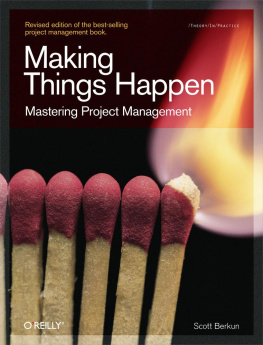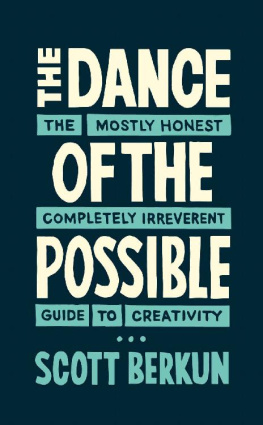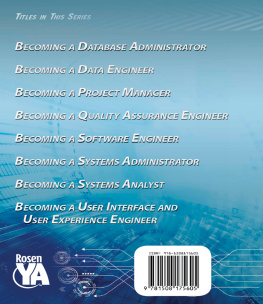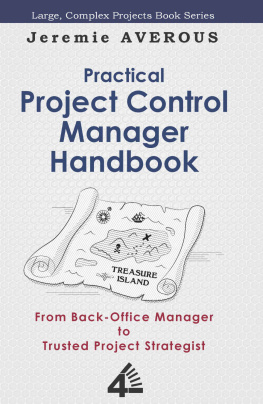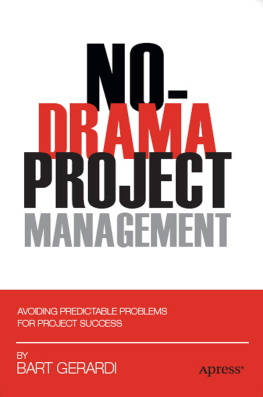Making Things Happen
Scott Berkun
Beijing Cambridge Farnham Kln Sebastopol Tokyo
Special Upgrade Offer
If you purchased this ebook directly from oreilly.com, you have the following benefits:
DRM-free ebooksuse your ebooks across devices without restrictions or limitations
Multiple formatsuse on your laptop, tablet, or phone
Lifetime access, with free updates
Dropbox syncingyour files, anywhere
If you purchased this ebook from another retailer, you can upgrade your ebook to take advantage of all these benefits for just $4.99. to access your ebook upgrade.
Please note that upgrade offers are not available from sample content.
FOREWORD
Something crazy happened with the first edition of this book. It sold lots of copies. It made several bestseller lists, was nominated for awards, and earned enough attention to send its author around the world to talk about ideas from the book. Then something crazier happened: the books title needed to change.
Taking this as an opportunity, the folks at OReilly and I agreed we should add more value to the book if it was going to have a second life with a new name. First published as The Art of Project Management , this text has been cleaned-up, enhanced, updated, and expanded for your pleasure. You may wonder why the title was changed. Here are some possibilities:
The Department of Homeland Security discovered a terrorist threat in the old title.
Tim OReilly realized his media empire could achieve instant world domination if he could just get owners of the first book to buy it a second time, under the ruse of a title change.
Whatever the reason, here we are. Ive done my best to improve this book without pulling a George Lucas Star Wars fiasco. Heres the birds-eye view of what has changed:
The text is revised for clarity and concision. Its a more confident, fluff-free book.
The addition of more than 120 thought-provoking exercises, appearing at the end of every chapter.
By popular demand, endnotes were promoted to footnotes, appearing within the chapter texts.
There is a new discussion guide to help you form groups to keep learning.
If you are new to this book in any form, the Preface will fill you in on everything you need to know.
Since the first edition was published two years ago, Ive been busy. I wrote another book called The Myths of Innovation ; created various essays, podcasts, and videos; and I continue to run a popular blog on creativity and management. Its all up at www.scottberkun.com; I hope youll stop by, as your purchase of this book helps make the many free things I produce possible.
Cheers and best wishes,
Scott Berkun
Redmond, WA
March 2008
PREFACE
My favorite word in the English language is how. How does this work? How was this made? How did they do this? Whenever I see something interesting happen, Im filled with questions that involve this small but powerful little word. And most of the answers I find center on how people apply their own intelligence and wisdom, rather than their knowledge of specific technologies or theories.
Over years of building things and comparing my experiences to those of other managers, programmers, and designers, Ive learned how to manage projects well. This book is a summation of those ideas. It includes approaches for leading teams, working with ideas, organizing projects, managing schedules, dealing with politics, and making things happeneven in the face of great challenges and unfair situations.
Despite the broad title of this book, most of my working experience comes from the tech sector, and in particular, Microsoft Corporation. I worked there from 1994 to 2003, leading teams of people on projects such as Internet Explorer, Microsoft Windows, and MSN. For a few years I worked in Microsofts engineering excellence group. While there, I was responsible for teaching and consulting with teams across the company, and was often asked to lecture at public conferences, corporations, and universities. Most of the advice, lessons, and stories in this book come from those experiences.
Although I come from a software and web development background, Ive written this book broadly and inclusively, calling on references and techniques from outside the engineering and management domains. There is great value here for people in the general business world. Im convinced that the challenges of organizing, leading, designing, and delivering work have much in common, regardless of the domain. The processes involved in making toaster ovens, skyscrapers, automobiles, web sites, and software products share many of the same challenges, and this book is primarily about overcoming those challenges.
Unlike some other books on how to lead projects, this book doesnt ascribe to any grand theory or presumptively innovative philosophy. Instead, Ive placed my bet on practicality and diversity. Projects result in good things when the right combination of people, skills, attitudes, and tactics is applied, regardless of their origin or (lack of) pedigree. The structure of this book is the most sensible one I found: focus on the core situations and provide advice on how to handle them well. Ive wagered heavily on picking the right topics and giving good advice over all other considerations. I hope you find that Ive made the right choice.
Who should read this book
To see if this book is for you, I suggest flipping back to the Table of Contents, picking a topic youre interested in, and skimming through what I have to say. I dont trust prefaces much, and I recommend you dont either; they rarely have the same style or voice as the rest of the book. But here goes anyway.
The book will be most valuable for people who fit themselves into one or more of the following categories:
Experienced team leaders and managers. This book is well suited for anyone playing a leadership role on any kind of project. The examples are from software development, but many concepts apply easily to other kinds of work. You might be the official team leader, or simply one of the more experienced people on the team. While some topics may be very familiar, the direct approach the book takes will help you clarify and refine your opinions. Even if you disagree with points I make, you will have a clear foundation to work against in refining your own point of view.
New team leaders and managers. If you look at the topics listed in the Table of Contents, youll find a solid overview of everything project leaders and managers actually do. Each chapter provides coverage of the common mistakes even experienced people make, with explanations as to why they happen and what tactics can be used to avoid them. This book provides you with a broader view of the new responsibilities youve taken on and the smartest ways to go about managing them. Because most chapters cover big topics, they often include annotated references to deeper sources.
Individual programmers and testers, or other contributors to projects. This book will improve your understanding of what youre contributing to, and what approaches you can use to be effective in doing so. If youve ever wondered why projects change directions so often or seem to be poorly managed, this book will help you understand the causes and remedies. If nothing else, reading this book will help you increase the odds your work will make a difference (and that you will stay sane while doing it). If you are interested in eventually leading teams yourself, this book will help you explore what that will really be like and whether you are cut out for it.

